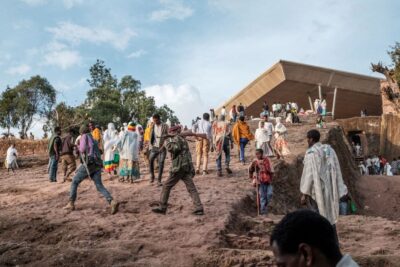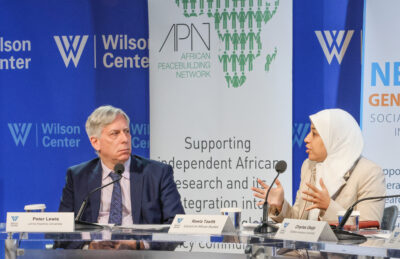New Orleans is often affectionately referred to as the Birthplace of Jazz. Whether through the city’s festivals that attract hundreds of thousands of attendees each year, its legendary musicians, or its dark and smoky clubs, this genre of music that demands both creativity and style—and where the concept of improvisation lies at the core of its successful performance—has become as synonymous with New Orleans as Mardi Gras. It is unfortunate, then, as we consider the loss of life and level of destruction left in the aftermath of Hurricane Katrina in September, 2005, that lack of improvisation at the organizational and multi-organizational level appears to be closely related to some of failures in the overall response.
Systematic research is needed to fully understand the successes and shortcomings in how organizations and citizens responded to the storm and subsequent overflowing of the city’s levees. However, a timeline of official statements as well as anecdotal accounts from individuals involved in the early operations suggests both a significant hesitancy to act and, perhaps more importantly, an inability to develop a shared understanding of roles, responsibilities, capacities, and the dire circumstances citizens were encountering.
Making sense of it all
Some officials indicated that what had unfolded in New Orleans was completely unexpected while at the same time, studies conducted by researchers1Laska, S. (2004). What if Hurricane Ivan Had Not Missed New Orleans? Natural Hazards Observer Vol. XXIX No. 2 November. had warned of the very circumstances that the world watched unfold on television and that New Orleanians suffered through. CNN analyzed its transcripts of statements issued by Michael Brown, chief of the Federal Emergency Management Agency (FEMA); Homeland Security Secretary Michael Chertoff; New Orleans Mayor Ray Nagin; evacuees; CNN correspondents; and others. What they found were very different interpretations regarding the state of security, conditions in the Convention Center where evacuees were sheltered, the federal response, and hospital evacuation. We heard reports of ice trucks, requisitioned by FEMA, waiting at their destinations for FEMA assistance and instead of unloading, calling the head office for advice on how to proceed. Amtrak indicated that its offer of a train was turned down, yet Mayor Nagin stated that he was unaware that the offer had been made. Buses were available, but officials stated the drivers were not. State officials were being blamed for turning back personnel and supplies while at the same time calling for assistance.2Foreman, T., and M.M. Ahlers, A. Cooper, (2005). People Making Decisions Hesitatedhttp://www.cnn.com accessed 9/13/05.
Some accounts have indicated that federal officials underestimated the storm’s strength and the extent to which a lack of local resources as well as political and economic contexts would limit local capacity in a large scale disaster, while local officials assumed that the federal government would rapidly deploy assistance as warranted.3Lipton, E. and C. Drew, S. Shane, and D. Rohde, (2005). Disarray Marked the Path from Hurricane to Anarchy http://www.nytimes.com accessed 9/10/05 At the same time, we should not overlook that local capacities that did exist were not always taken into account, including the extent to which representatives from vulnerable segments of the population could have been involved in planning efforts regarding evacuation and sheltering of those residents without access to transportation.
At times, FEMA, state, and local officials seemed unaware of local capacities and vulnerabilities. On the one hand, one local official stated, “FEMA’s deference was frustrating. Rather than initiate relief efforts—buses, food, troops, diesel fuel, rescue boats—the agency waited for specific requests from state and local officials.” On the other hand, communication failures left local officials unaware of the full extent of assistance required. As this state official commented, “If you do not know what your needs are, I can’t request to FEMA what I need.”4Lipton, E. and C. Drew, S. Shane, and D. Rohde, (2005). Disarray Marked the Path from Hurricane to Anarchy http://www.nytimes.com accessed 9/10/05.
In other words, what we saw were failures to collectively make sense of the disaster and what was necessary to respond to it. Sense-making, a concept developed most comprehensively by Weick5Weick, K.E. 1990. Technology as Equivoque: Sensemaking in New Technologies. In Technology and Organizations, eds. P.S. Goodman, L.S. Sproull, and Associates, pp. 1-44. San Francisco, CA: Jossey-Bass Publishers. Weick, K.E. 1993. The Collapse of Sensemaking in Organizations: The Mann Gulch Disaster.Administrative Science Quarterly 38: 628-652. Weick, K.E. 1995. Sensemaking in Organizations. Thousand Oaks: Sage Publications. is concerned with how people and organizations, constructing meaning in their environment, “construct what they construct, why, and with what effects.”6Weick, K.E. 1995. Sensemaking in Organizations. Thousand Oaks: Sage Publications. (page 4) It is a concept that is closely connected to the ability to improvise, or to rework knowledge in novel ways under tight time constraints.
Disaster Improvisation
Disasters provide an opportunity to observe social structures as they emerge and how those structures function under stressful conditions.7Dynes, R.R. 1970. Organized Behavior in Disaster. Lexington, MA: D.C. Heath. Kreps, G.A. 1989. Social Structure and Disaster. Newark, Delaware: University of Delaware Press. The intersection between organizational stability and emergence is deeply rooted in the sociological research tradition on disasters. This research is well represented by a large body of literature examining emergent groups,8Kreps, G.A. 1989. Social Structure and Disaster. Newark, Delaware: University of Delaware Press. Nigg, J.M 1979. The Emergence of Issues and Collective: Community Response to Earthquake Prediction and Its Consequences. Dissertation thesis, University of California, Los Angels, CA. Quarantelli, E.L. and R.R. Dynes. 1977. “Response to Social Crisis and Disaster.” Annual Review of Sociology 3: 23-49. Stallings, R.A, and E.L. Quarantelli. 1985. “Emergent Citizen Groups and Emergency Management.” Public Administration Review 45: 93-100. organizations that form new or altered organizational structures and perform non-routine tasks in a disaster,9Dynes, R.R. 1970. Organized Behavior in Disaster. Lexington, MA: D.C. Heath. organizational adaptation in disaster,10Stallings, R.A. 1970. “Hospital Adaptations to Disaster: Technologies.” Human Organizations 29: 294-302. Kendra, J.M. and T. Wachtendorf. 2003. Elements of Resilience after the World Trade Center Disaster: Reconstituting New York City’s Emergency Operations Centre. Disasters 27(1): 37-53. improvisation within organizational domains, human and material resources, tasks, and activities,11Kreps, G.A. and S.L. Bosworth, with J.A. Mooney, S.T. Russell, and K.A. Myers. 1994. Organizing, Role Enactment, and Disaster: A Structural Theory. Newark, DE: University of Delaware Press. role improvisation,12Kreps, G.A. and S.L. Bosworth. 1993. “Disaster, Organizing, and Role Enactment: A Structural Approach.”American Journal of Sociology 99(2): 428-463. Quarantelli, E.L. and R.R. Dynes. 1977. “Response to Social Crisis and Disaster.” Annual Review of Sociology 3: 23-49. Webb, G.R. 1998. “Role Enactment in Disaster: Reconciling Structuralist and Interactionist Conceptions of Role.” Dissertation thesis, University of Delaware, Newark, DE. and struggles for enhancing improvisation through decision-support tools.13Mendonca, D., G.E.G. Beroggi, and W.A. Wallace. 2001. “Decision Support for Improvisation During Emergency Response Operations.” International Journal of Emergency Management 1(1): 30-38.
Disasters may cripple a social system, but they do not completely destroy it.14Dynes, R.R. 1970. Organized Behavior in Disaster. Lexington, MA: D.C. Heath. Kreps, G.A. 1989. Social Structure and Disaster. Newark, Delaware: University of Delaware Press. Indeed, the ‘disorganization’ that is sometimes seen after a disaster event is primarily the process of communities adapting to a newly emerging environment and new circumstances. The new social arrangements that emerge in a disaster situation are tightly coupled to previously existing arrangements.15Kendra, J.M. and T. Wachtendorf. 2003. Elements of Resilience after the World Trade Center Disaster: Reconstituting New York City’s Emergency Operations Centre. Disasters 27(1): 37-53. Kreps, G.A. and S.L. Bosworth. 1993. “Disaster, Organizing, and Role Enactment: A Structural Approach.” American Journal of Sociology 99(2): 428-463. Quarantelli, E.L. and R.R. Dynes. 1977. “Response to Social Crisis and Disaster.”Annual Review of Sociology 3: 23-49. Wachtendorf, T. 2004. Improvising 9/11: Organizational Improvisation Following the World Trade Center Disaster, Dissertation #35, Disaster Research Center: Newark, DEhttp://www.udel.edu/DRC/dissertations.html or http://www.riskinstitute.org Pre-arranged structures, planned actions and responsibilities, and acquisition of anticipated resources form the basis for decision-making in emergent environments. This planning informs decisions by anticipating possible challenges or pitfalls that could come as a consequence of improvised activities. Planning is designed to provide some element of stability—whether of organizational structure, role, task responsibility, resources, or the physical environment—when other elements are in flux or situations demand unplanned-for action.
According to Shibutani, “if the normative framework does not provide an adequate guide to concerted action, the people involved in the situation must work together to improvise some way of coping with it.”16Shibutani, T. 1986. Social Processes. An Introduction to Sociology. Berkeley, CA: University of California Press (page 269) Improvisers must understand the changed environment, which depends on cues and retrospection,17Weick, K.E. 1995. Sensemaking in Organizations. Thousand Oaks: Sage Publications. but there is also an element of projection, as the improviser cognitively fits a new action into a changed setting and assesses what its efficacy might be based on a hypothesis of what the new conditions are. Not only must the improviser determine whether or not pre-existing plans exist to account for various aspects of the disaster, they must also determine whether or not those plans can be carried out and whether or not they are appropriate given emerging needs.18Wachtendorf T. and J.M. Kendra, (2005). A Typology of Organizational Response to Disasters, Presentation to the American Sociological Association, Philadelphia, PA. Aug 14.
Waterborne Efforts: Success in the City of New Orleans and New York City
It is noteworthy that in this early stage of assessing the response, one of the activities that has received considerable praise was also one that involved significant improvisation: the water and airborne search and rescue operation. The United States Coast Guard deployed to flooded areas of New Orleans in an effort to save stranded citizens trapped in attics, clinging to floating debris, or marooned for days without food or water on partially submerged rooftops. The agency is reported to have rescued twice the number of people in the aftermath of Hurricane Katrina than it had over the past half century.19Author Unknown (2005). Time running out for survivors: Rescuers: Not enough resources to save all in New Orleans http://www.cnn.com accessed 9/4/2005 As accounted in a Washington Times editorial, More than a Coast Guard,20Editorial (2005). More than a Coast Guard, Washington Times http://www.washtimes.com/op-ed/20050908-090641-4058r.htm accessed 9/4/2005. the United States Coast Guard, whose staging station in Gulfport, Mississippi was destroyed as a consequence of the hurricane, operated outside of its normal scope of work, and rescued what has been estimated as over 22,000 people in a hazardous and constantly-changing urban disaster environment. Lt. Rob Wyman, information officer for the agency, told the Times, “We’re flexible, we’ll modify and we’ll do whatever we can to help people in need.”
The Coast Guard did not act alone in its sizeable rescue effort. An emergent and ephemeral flotilla of civilian boat operators also converged on the heavily damaged areas, both on their own initiative and in response to a call for assistance by political leaders. The ability of Coast Guard operational commanders to act relatively autonomously in the field, a strong-hold of experienced personnel, versatile training, an organizational environment that combines uniformed and civilian operations, and the development of a shared vision of what was necessary by both Coast Guard and civilian boat operators facilitated the ability to improvise at a multi-organizational level.
Interestingly, one of New York City’s most dramatic (albeit rarely mentioned) improvised response activities on September 11th, 2001 was the waterborne evacuation of Lower Manhattan. With many transportation routes cut-off as a result of the attacks, commuters and residents had relatively few options for fleeing the area. While many walked north or over bridges, others found themselves along the southern shore of the island. The harbor community did not have plans to execute a mass evacuation of the City, but vessels converged—again, some on their own initiative and others in response to the Coast Guard’s call for all available boats—to improvise a successful evacuation of hundreds of thousands of people. In fact, ferries, tugs, dinner cruise boats, and other private vessels played an even more significant role in the operation than actual Coast Guard vessels. This same operation quickly became involved in transporting critical equipment, supplies, and personnel to Manhattan on return trips to collect more evacuees.21For information on the Disaster Research Center and Emergency Administration and Planning Program’s study of the September 11, 2001 waterborne evacuation of Lower Manhattan, see www.udel.edu/DRC Like the operation in New Orleans, vessel operators in New York harbor were able to effectively make sense of their social and physical environment while simultaneously acting within that environment.
Planning vs improvisation
It is easy to see the development of comprehensive plans and the need to improvise as opposites. We should not be too quick, however, to view improvisation solely as evidence of failures on the part of organizations and governments. Improvisation has an important role in disaster management. At the same time, to discount the importance of pre-disaster planning is not only short-sighted but ignores the important role planning plays in enabling improvisation. Despite his sarcasm, New York Times columnist David Brooks22Brooks, D., (2005). The Best-Laid Plan: Too Bad It Flopped. http://www.nytimes.com accessed 9/11/2005 makes very astute points regarding the hubris in over-reliance on plans, yet his conclusion that what transpired in New Orleans demonstrates a need for reduced government involvement in disasters is misplaced.
Ironically, Brooks’ op-ed appeared in a New York publication on the fourth anniversary of the World Trade Center disaster. New York City’s response demonstrated many ways that effective planning and improvisation can work in concert with each other.23For a more detailed discussion, see T. Wachtendorf (2004) “Improvising 9/11: Organizational Improvisation Following the September 11, 2001 World Trade Center Disaster, Dissertation #35, Disaster Research Center: Newark, DE http://www.udel.edu/DRC/dissertations.html orhttp://www.riskinstitute.org When the City found itself without a back-up facility after the destruction of its Emergency Operations Center (EOC) at 7 World Trade Center, organizations quickly improvised an alternative site, first in the Police Academy library and later at a pier facility on the Hudson River. Despite the lack of a contingency plan for the EOC, prior planning contributed to a shared vision of the site’s operational purpose, which facilitated its equipping and operation. The Office of Emergency Management’s high standing involvement of the Mayor in planning, and ongoing relationships developed between agencies (particularly in preparation for Y2K), were key in developing mutual understanding of resources and needs and familiarity with city agencies in a disaster context through frequent disaster exercises. In fact, the pier facility that eventually housed the improvised EOC was scheduled to have been the site of a bio-terrorism drill scheduled on September 12, 2001. When the City did not have plans for the complex debris removal and remains recovery operation necessary after the World Trade Center collapse, organizations with little role in prior planning efforts emerged as important participants and improvised an extensive operation at both Ground Zero and the Fresh Kills Landfill site. Yet they acted decisively, drawing upon a network of contractors and personnel developed through routine operations but which also connected them to capable participants outside of their immediate network but in the network of others. The decentralized operation allowed for flexibility by organizations involved in the various response functions, but when communication within and between functions prevailed, the response flourished.
We must remember that the very definition of a disaster, that circumstances have exceeded a community’s ability to cope, implies that some form(s) of improvisation will be necessary.24Tierney, K.J. (2002). ”Lessons Learned from Research on Group and Organizational Responses to Disasters.” Paper presented at Countering Terrorism: Lessons Learned from Natural and Technological Disasters. Academy of Sciences, February 28 – March 1. If initial newspaper accounts prove accurate, the response failures in New Orleans shared inflexibility as an underlying cause. These failures were related to an inability of various government levels to construct a shared vision of what needed to be done. They were related to an inability to communicate effectively across various levels and with community constituents (in part due to the breakdown of communication technology, but also due to breakdown in organizational communication). These failures were related to an inability to understand what plans were really out there and how they had already been changed during the disaster response. And they were related to an inability to adapt plans appropriately given emerging needs.
When documents gather dust in desk drawers or serve to simply legitimize organizations—plans can become what Lee Clarke25Clarke, L. 1999. Mission Impossible: Using Fantasy Documents to Tame Disasters. Chicago, IL: University of Chicago Press. terms “fantasy documents” or plans that unrealistically expect to cover every contingency. They can work to paralyze an organization or render a multi-organizational response unable to even identify what needs to be done in a quickly changing environment. But when plans allow for a smooth response to anticipated contingencies, they can free up time and personnel to concentrate on aspects of a response that were unanticipated and facilitate a reworking of existing resources to better meet emergent demands. Planning is, indeed, critical. When organizations plan, they enhance their capabilities. But the development of a plan should be of secondary importance to the planning process, which in addition to outlining appropriate courses of action also allows participants to learn about one another’s skills and capabilities and to assemble those as needed to meet unexpected dangers—in other words, to improvise. Good planning enables flexibility, construction of shared visions, awareness of capacities and vulnerabilities, and communication that facilitates the improvisation that is needed in a disaster.
Failure of planning in New Orleans does not negate the need for planning; nor does it call for a redirection toward the wholesale development of hierarchical, command-and-control structures. That model often discounts the role of citizens and non-governmental organizations—seeing them as inept, passive, and irrational. It views information from non-official channels as lacking or inaccurate, assumes standard operating procedures will always function adequately in disasters, anticipates a breakdown of society in disaster, and considers ad hoc emergence as counterproductive.26Drabek, T.E. and D.A. McEntire (2002). “Emergent Phenomena and Multi-organizational Coordination in Disasters: Lessons from the Research Literature.” International Journal of Mass Emergencies and Disasters, 20(2): 197-224. Ultimately, the command and control approach leads to ineffective disputes about who is in charge, an inability to serve a diverse community, and subsequent ineffective coordination.
Rather, what is called for is responsible government at all levels. A strong and responsible government can provide necessary stability while enabling improvisation and community-based participation. Government must see planning as a process that, when done effectively, is less about determining who is in charge than it is about working together at all levels (public and private) toward a shared vision and a shared understanding of what is needed. Admittedly, this is extremely difficult to achieve in the dynamic and ambiguous setting of a disaster, particularly when communications systems are destroyed. That’s why the groundwork is best laid before disaster strikes. The role of higher government levels, when most effective in the disaster planning and response context, is to acknowledge community capacities and assist in ways to reduce or compensate for their vulnerabilities. In other words, the planning and improvisation failures in New Orleans do not support an argument for less government, but rather government in an enabling role.
Planning to Improvise?
In the 9/11 Commission report, the authors commended the “good instincts and good will” of the many who rose to the occasion in responding to the attacks. However, effective improvisation strategies involve more than common sense, good instincts, or good will, and we must learn more about improvisation if we are to avoid some of the failures of the Hurricane Katrina response.
A great jazz musician or improv actor, after all, must do more than simply make “something out of nothing.”27Berliner, P.F. 1994. Thinking in Jazz: The Infinite Art of Improvisation. Chicago, IL: University of Chicago. (page 492) Spontaneous composition of music and performance depends on the ability to draw upon a repertoire of training, experience, and a shared vision with fellow performers. Performers must be skilled in reading their cues and making sense of the performance’s direction. Similarly, an emergency responder—whether a formal or informal responder—must be able to draw upon a repertoire of training or education, experience, knowledge of the community, and a shared vision with other organizations. These repertoires are what help responders make sense of an emerging disaster environment and are what facilitate effective improvisation.
Lack of imagination can stifle improvisation and the ability to make sense of new situations, but the preconditions for imaginative and flexible action are well-known. These include a culture of curiosity; constant review of procedures (even successful ones); decision making authority that is free to move close to the action; an ability to set aside habits that suddenly become obsolete; and an incentive structure that rewards good performance and tolerates honest error. To the extent that our agencies are able to meet the pre-conditions for flexible action, their ability to confront shifting threats will be enhanced. Similarly, failure to meet these well-recognized conditions will impede the ability to meet new dangers and lead, at best, to “planning for the last disaster.” The goal must be to create “learning organizations” that have the collective ability to think about the environment; to pick up signals; compare them with what is known, and then assess what is needed to fill in gaps in knowledge. Structural change is important, but cultural change is important, too.
There are many lessons we should take away from this tragic disaster. Among them, we must outline authority and accountability as well as foster multi-organizational communication, coordination, and improvisation in complex and turbulent environments. We must understand that our interpretation of our social and physical environments can be just as important as the environments themselves. We must work to better recognize our capacities and vulnerabilities and communicate them to other organizations within our networks. Planning and improvisation are important to achieving an effective disaster response, and building resilient networks before disaster strikes can work to accomplish both. These networks will help the country both imagine new threats and improvise in response to the more diffuse and complex regional, national, and global disasters we, unfortunately, are likely to see in the future.
As time passes, we will likely hear of other improvisation examples that took place in the City of Jazz during that disastrous week in September. The lack of improvisation at some levels of government likely necessitated improvisations by resource-stretched police officers on the streets, hospitals without power trying desperately to care for patients, and most certainly citizens stranded within the city trying desperately to survive. In the end, we may indeed find that many of our lessons on improvisation come from the streets—or the rooftops—of New Orleans.
Tricia Wachtendorf is assistant professor of sociology at the University of Delaware and a member of the core faculty at its Disaster Research Center.
James M. Kendra is assistant professor of public administration at the University of North Texas and the program coordinator of its Emergency Administration and Planning Program.28Reflections on organizational improvisation in response to Hurricane Katrina are informed by projects funded by the Multidisciplinary Center for Earthquake and Engineering Research (MCEER), New Technologies in Emergency Management, No. 00-10-81 and Measure of Resilience, No. 99-32-01, by the Public Entity Risk Institute No. 2001-70, the National Science Foundation supplemental grant EEC-9701471 (Special thanks to Kathleen J. Tierney, PI for above projects) as well as the University of Delaware Research Foundation and newly awarded National Science Foundation grant to study the waterborne evacuation of Lower Manhattan No. 0510188. The opinions expressed here are solely those of the authors.













